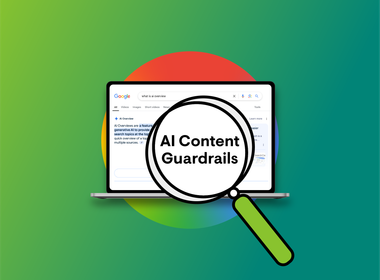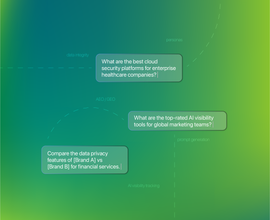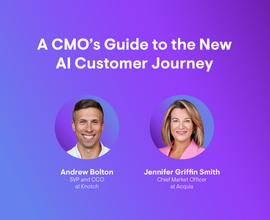What are AI Content Guardrails & Why do You Need Them?
The speed and scale of AI writing tools promise new levels of efficiency, but they also introduce a critical challenge: how do you ensure the content created is something your brand can actually use? Without enough guidance and context, AI can generate content that quickly goes off the rails, using incorrect terminology, missing your brand’s voice, and even failing to meet compliance standards. This is where content guardrails come in.
Just like guardrails on a highway, they are an AI safety feature that allows brands to better harness AI safely and effectively.
What are content guardrails in AI writing?
Content guardrails are a set of rules and guidelines that inform an AI writing tool on how to generate content that aligns with a brand's specifications. These guardrails act as a line of defense to maintain your brand’s authority, ensure compliance, and enforce a consistent tone when leveraging AI-generated content. This helps to ensure that AI produces content that is high-quality and on-brand.
Content guardrails are important when it comes to maintaining your brand voice, making sure everything is factually accurate/aligned with your internal compliance standards. After all, AI content generation can scale, but the more important consideration for marketers is: can you scale without sacrificing quality?
Content guardrails can be implemented in two primary ways:
- Platform-native guardrails: These are safety features built directly into the AI product by the company that created it. Examples of this can include filters to block specific language, features to set a desired tone and voice, or tools to check for plagiarism.
- Process-based guardrails: These are guidelines and checkpoints developed internally by a brand as part of its content workflow. This provides an added layer of protection, as the quality and enforcement of built-in guardrails can vary between AI tools. Some examples of these guardrails are creating a prompt library, maintaining a list of words and phrases to avoid in content, and ensuring that a thorough human-led review is part of the process for all AI-generated drafts.
Evaluating guardrails in AI platforms
When choosing an AI writing tool, it's critical to evaluate its built-in safety features. Don't take claims of "brand safety" at face value. Ask specific questions about their capabilities:
- Customization: Can you customize the guardrails? For instance, can you upload your brand's specific style guide, define a unique tone of voice, or provide a list of approved product names and terminology?
- Fact-Checking: Does the platform have a mechanism to fact-check its own output, such as using Retrieval-Augmented Generation (RAG) to ground its answers in real-time, factual data?
- Source Transparency: Does the tool show you where it's getting its information? The ability to see and verify sources is a crucial guardrail against inaccurate information.
Implementing guardrails in your content workflow
Even with a great tool, your internal process is your most important guardrail.
- Store successful prompts in a prompt library: Create a unified library of approved, detailed prompts for completing common content tasks. This ensures consistency and reduces the risk of users creating low-quality content with vague prompts.
- Create a brand "brain": Compile all your brand guidelines, style guides, key messaging documents, and best-performing content into a centralized knowledge base. Use this to inform your prompts and provide the AI with approved source material.
- Mandate human review: Institute a non-negotiable policy that every piece of AI-generated content must be reviewed, edited, and approved by a human expert before it is published. The AI is a powerful assistant, but the human is the editor-in-chief.
How Conductor implements AI content guardrails
Advanced platforms like Conductor build content guardrails directly into the AI engine to provide a safer and more reliable experience from the start.
Content score, within Writing Assistant, is our methodology for actually using large language models to evaluate how good your content is. And then the way that we evaluate this is all about how well your content meets the search intent of the user, rather than stuffing the content with unrelated information.
Conductor also leverages its RAG technology to ensure that AI-generated recommendations and content are grounded in real-time, verifiable data, including your own analytics and content.
Conductor helps when it comes to content guardrails by making sure that AI-generated content [from Writing Assistant] aligns with your brand voice, tone, and messaging guidelines. Retrieval Augmented generation is a big part of that, but that’s also really why we created our Content Profiles.
By connecting to your specific data, Conductor's AI operates within the context of your business, ensuring the output is not just generic but highly relevant and factually based. This built-in process acts as a foundational guardrail that minimizes risks and maximizes the strategic value of every AI-powered insight.
FAQs
- What is an answer engine?
- What is AI optimization?
- What is a knowledge cutoff?
- What are AI hallucinations?

![Jenny Li, Director of Product Marketing, [object Object]](https://cdn.sanity.io/images/tkl0o0xu/production/0cf2880c77e134c2c52395bb7906a3ac8d2e4dc4-300x300.jpg?fit=min&w=100&h=100&dpr=1&q=95)
![Wei Zheng, Chief Product Officer, [object Object]](https://cdn.sanity.io/images/tkl0o0xu/production/dcfa62c0fe34ba0c31f910b818874cd160ad8839-3542x3542.png?fit=min&w=100&h=100&dpr=1&q=95)
![Alexandra Dritsas, Principal Solutions Consultant, [object Object]](https://cdn.sanity.io/images/tkl0o0xu/production/56e05fe9c1e6c71cd4fa8ed0e6368e43c9679480-1765x1765.png?fit=min&w=100&h=100&dpr=1&q=95)






